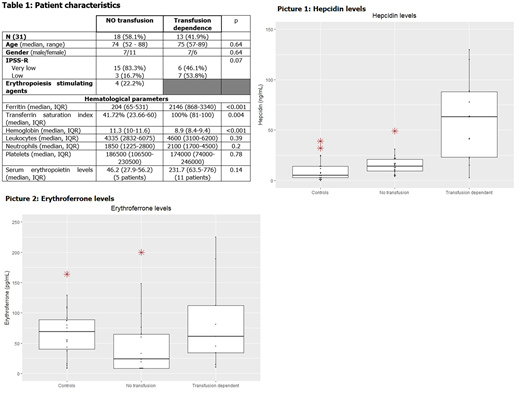Abstract
BACKGROUND: Anemia is the most common manifestation of low-risk myelodysplastic syndromes (MDS). Iron-overload in MDS can occur before transfusion dependence in the context of ineffective erythropoiesis. Significantly lower hepcidin levels have been described in patients with sideroblastic refractory anemia compared to higher risk MDS, promoting inadequate iron absorption that leads to higher iron overload. Erythroferrone (ERFE) is a hormone that stimulates erythropoiesis and regulates iron homeostasis; in physiological conditions, is stimulated by erythropoietin and increases iron absorption inhibiting hepcidin. There are no studies describing the activity of ERFE in MDS. The objective of this study was to describe the relationship among hepcidin, ERFE and iron overload in 31 patients with low-risk MDS.
METHODS: 50 samples were analized, 31 from patients (16 males, 17 females) with low-risk MDS: 10 low IPSS-R and 21 very-low IPSS-R; and 19 from healthy controls. 13 patients showed severe anemia with transfusion dependence, 4 patients received only erythropoiesis stimulating agents (ESA) and 14 patients did not receive any treatment for the anemia. Patient characteristics are summarized in table 1. Hepcidin levels were measured using the DRG Hepcidin 25 (bioactive) HS ELISA Kit (DRG Diagnostics GmbH), and ERFE was measured with the FAM132B (Human) OKEH02395 ELISA kit (Aviva Systems). For the analysis, two groups of patients were considered: 13 with severe and transfusion dependent anemia and 18 with mild/moderate anemia.
RESULTS: Patients with severe anemia showed higher serum ferritin levels (median 2143ng/mL vs 204ng/mL, p<0.001) compared to patients without transfusion dependence. Hepcidin levels were significantly higher in patients with transfusion dependent anemia (mean 59.85 vs 16.11ng/mL, p=0.001) compared to patients with transfusion independence, and were also higher in these last patients compared to healthy controls (mean 16.11 vs 10.6ng/mL, p<0.001). Regarding ERFE, patients with transfusion dependent anemia showed significantly higher ERFE levels (mean 281.92 vs. 62.83pg/mL, p=0.016) than patients with mild/moderate anemia. However, there were no significant differences between patients with mild/moderate anemia and healthy controls. There was no correlation between hepcidin and ERFE levels (p=0.46).
CONCLUSIONS: To the best of our knowledge, this is the first simultaneous analysis of hepcidine and ERFE in MDS. Patients with severe anemia showed significantly higher ERFE levels compared to those with moderate anemia, suggesting a higher erythropoietic stimulus. Patients with severe anemia showed significantly superior hepcidin levels, hindering iron absorption in situations of massive iron overload. Accordingly, ERFE did not show negative correlation with hepcidin in either cohort, supporting the abnormal iron metabolism in MDS. Larger studies are required to define the relationship between hepcidin and ERFE in low-risk MDS.
No relevant conflicts of interest to declare.
Author notes
Asterisk with author names denotes non-ASH members.


This feature is available to Subscribers Only
Sign In or Create an Account Close Modal